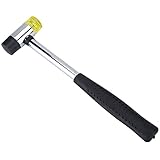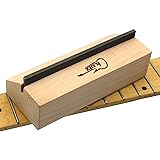All Categories







Ez-Barre Guitar Tool, Use the Combined Strength of Three Fingers to Easily Form Pain Free Barre Cords
Share Tweet








Ez-Barre Guitar Tool, Use the Combined Strength of Features
-
A barre chord is formed when all six strings of your guitar are fretted at a single fret. Seasoned players must develop finger strength and callouses to do this with one finger. The Ez-Barre will allow you to do this right away.
-
Open tuning is when all six strings of the guitar are tuned to form a chord. If you tune to a major chord, by moving up the fretboard with barre chords, all major chords are available. The most popular major open chords are “C”, “D” and “G”.
-
The most common chord in any song is the major chord. To produce this chord, you will just strum all six strings without any fretting, as your strings are tuned to this chord. The other two chords you will need, the IV and V chords, will be obtained by barring on the fifth and seventh frets.
-
This design features utmost simplicity: a rugged polypropylene body, and a PVC tube, secured in a channel, which contacts the strings.
-
Works with most guitars and ukuleles. Will not work with classical guitars.
-
Invented and designed in the USA.
About Ez-Barre Guitar Tool, Use The Combined Strength Of
The top of the Ez-Barre has two ribs that you can grip with your first three fingers. On the bottom is a channel to secure a PVC plastic tube. This tube frets the strings. To use of the Ez-Barre to accompany simple songs, you must retune your guitar, so that when all six strings are strummed, you play a major chord. The standard tuning, from the 6th string to the 1st string is EADGBE. The most common open tunings are C, D and G. For example, tuning to produce the G major chord: 6th string down to D, 5th string down to G and 1st string down to D. All other strings as normal. There are sites on the internet which will give you specific frequencies to do this, or you can buy a chromatic tuner. Now, with this G major tuning, when you accompany your songs, you obviously will be playing in the key of G. The major chord, G will be produced simply by strumming all the strings. The IV chord, “C”, is produced by forming a barre chord at the 5th fret. The V chord, D, is produced by forming a barre chord at the 7th fret. You are now ready to accompany thousands of simple 3 chord songs. The guitar is normally tuned to equal temperament; the octave is divided into 12 equal steps which allows us to play in all keys. The downside of this, in the key of G, for example, there will be some “beating” between the G string and the B and D strings. By making a slight tuning adjustment to the B and D strings, the beating will stop and the chord will sound better. We must realize too, that not only the tuning is a compromise, but also the diameters of the guitar strings. If you want to produce the most beautiful major chord that is possible in any key, you must restring your guitar specifically for that key! Here I can’t help you. A musical friend suggested two possibilities for the key of C: CGCEGC (2 octaves) and CEGCEG (1.5 octaves). You will get simple directions and tuning suggestions.





















